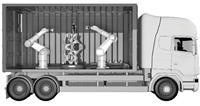Automated Robotic Fabrication for Temporary Architecture: Rethinking Plastics

This article discusses digital fabrication processes for temporary structures composed of biodegradable plastics. The objective of the research is to investigate robotic fabrication methods, specifically targeting bioplastics. The article discusses material properties, fabrication techniques, structural properties, and a case study. The case study presents design and robotic fabrication methods for temporary pavilions in London. The fabrication process takes place in a mobile cell autonomously run by robots. Once the temporary structure is no longer in use, the unique property of the material fabrication system allows the built structure to be shredded down and refed into the fabrication system to build a new temporary architecture nearby or on another site.
keywords: material programming, bioplastics, robotics, 3D printing, digital fabrication


Add comment
Log in to post comments